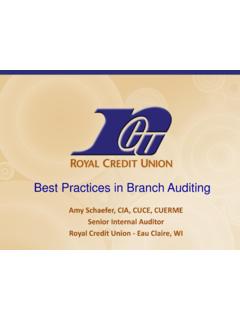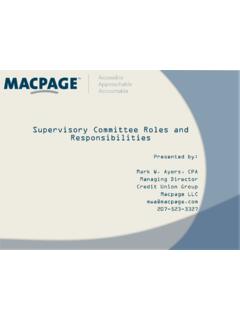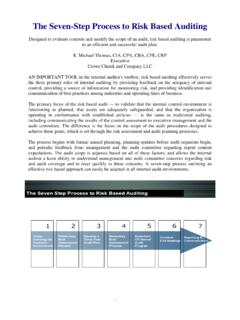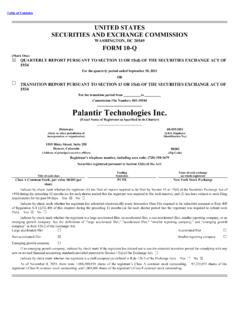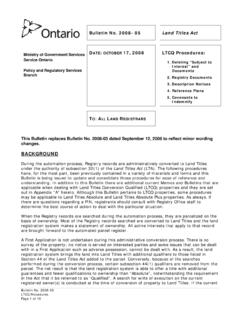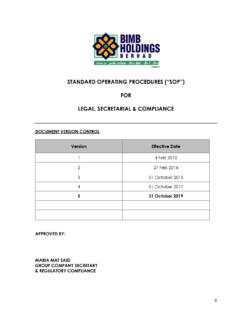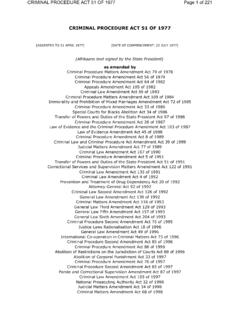Transcription of Best Practices for a Highly Effective Internal Audit Function
1 1 Best Practices for a Highly Effective Internal Audit Function Ryan Sturgis, Senior Manager Aran Loftus, Manager 2 The material appearing in this presentation is for informational purposes only and should not be construed as advice of any kind, including, without limitation, legal, accounting, or investment advice. This information is not intended to create, and receipt does not constitute, a legal relationship, including, but not limited to, an accountant-client relationship. Although this information may have been prepared by professionals, it should not be used as a substitute for professional services. If legal, accounting, investment, or other professional advice is required, the services of a professional should be sought.
2 3 AGENDA 4 SNAPSHOT AGENDA What is Internal Audit ? Planning and risk assessment Resource management Reporting considerations Measuring effectiveness Adding value Relationship building I m just one auditor! Best Practices 5 WHAT IS Internal Audit ? 6 DEFINITION OF Internal AUDITING Internal auditing is an independent, objective assurance and consulting activity designed to add value and improve an organization's operations. It helps an organization accomplish its objectives by bringing a systematic, disciplined approach to evaluate and improve the effectiveness of risk management, control, and governance processes - The Institute of Internal Auditors, April 2013 7 INDEPENDENT AND OBJECTIVE Who are you reporting to?
3 Are you and your staff sufficiently removed? Development of an Internal Audit charter oDescribes objective and scope oDescribes reporting, authority, and responsibility oApproved by the Supervisory/ Audit Committee oGives authority to the Internal auditor 8 SYSTEMATIC AND DISCIPLINED Are there internally defined standards for conducting, reviewing, and reporting work? International Standards for the Practice of Internal Audit (Institute of Internal Auditors Standards) oCode of ethics oEstablishes a framework for Internal Audit work oRecognized as the authoritative standards External review oAuditors will be examining in more detail oPeriodic third party assessments 9 INTERAGENCY GUIDANCE Interagency Policy Statement on the Internal Audit Function and Outsourcing oIssued in 2003, following the implementation of Sarbanes-Oxley oUpdated by the Federal Reserve in January 2013 oProvides standards for establishment of.
4 Internal Audit programs Evaluation of third parties Responsibility of the Audit Committee Relationship between Audit and risk Management 10 REGULATORY FOCUS Federal Reserve has issued an updated policy statement on the Internal Audit Function and the Office of the Comptroller of the Currency has proposed guidance for large institutions oEncouragement to adopt professional standards issued by the Institute of Internal Auditors and develop stated policies, procedures , and controls Examiners increasingly including the Internal Audit Function in procedures Trend is to allow examiners further ability to rely on Internal auditors External auditors can rely upon Internal auditors, however requires assessment of the Internal Audit Function , policies, and procedures 11 PLANNING AND RISK ASSESSMENT 12 PLANNING - GENERAL When was the last time you revisited your Audit programs?
5 Fixed versus adaptive scheduling Seeking management input when developing Audit timing and procedures Taking a cue from the external auditor oUnderstanding the entity oRisk assessment oWalkthroughs oTesting 13 PLANNING - RISK ASSESSMENT How is management monitoring risk? What controls and policies are in place? Are these monitoring activities and policies Effective ? What accepted risks is management taking? What are the most important control systems? Are certain areas being overlooked in audits? oMaterial estimates oTechnology oVendor management 14 HOW TO GET STARTED Gain an Understanding of the Area to be Audited oDevelop an Audit Universe to identify major controls that must be audited oInterview key personnel to gain an understanding of those products, services and functions the business unit is responsible for oDecide which controls are important in executing the Audit oIs sampling an option?
6 15 DEVELOPING AN Audit UNIVERSE Multiple approaches, which may include: oProcess Level This approach aligns the universe with key processes (examples: loan origination, loan servicing, new account opening, etc.). oFunctional Level This approach is developed by business or responsibility unit ( branch or department) Audit universe is a list of all auditable entities or functions. oProduct Level This approach focuses on specific product (examples might be SBA Lending, certificate of deposit, etc.) Business units (branches, lending operations, accounting, etc.) oBusiness Level (Enterprise Risk) This approach focuses on key risks in the organization and prioritization of Internal audits in those key risk areas.
7 16 SIMPLE EXAMPLE - Audit UNIVERSE ExampleRisk AssessmentAs of : November or ActivityUnitSub-UnitAdditional InformationFocus Issues1 Allowance for lossesAccounting and FinanceCredit RiskPrepared byCalculation and methodology2 BudgetingBank Administration3 Capital planBank Administration4 Cash flowsAccounting and Finance5 Closing books monthly, quarterly, annuallyAccounting and Finance6 Correspondent banksAccounting and Finance7 Due from bank reconcilementsAccounting and Finance8 Fed fund lines-correspondent banksAccounting and FinanceYield Analysis9 Fed fund lines-correspondent banksWire DepartmentInvestment and borrowing transactions10 Fed funds settlementAccounting and Finance11 Federal Home Loan Bank relationsAccounting and Finance12 Financial statementAccounting and Finance13 General ledger reconciliationAll Department14 Interest Rate RiskAccounting and FinanceOutside consulting firm15 Journal entriesAccounting and Finance16 LiquidityAccounting and FinanceAudit Universe17 CREATING A RISK
8 ASSESSMENT Utilize a basic risk assessment scenario avoid models that are exceedingly complex, unless your corporate structure warrants this. Guidance for risk assessment may include: oFederal Reserve s Framework for Risk Focused Supervision of Large Complex Institutions oOffice of the Comptroller of Currency (OCC) Handbook Large Bank Supervision oCOSO Internal Control Integrated Framework 18 KEY COMPONENTS OF RISK ASSESSMENT A SHORT GLOSSARY Audit Universe Collection of all business units, functions or activities that should be subject to Audit Inherent Risk Probability that loss or other undesirable event will occur absent of any controls to help mitigate or control risk Controls Activities or processes implemented by management which serve to reduce risk to an acceptable level Mitigated Risk Probability that loss or other undesirable event will occur taking control processes into consideration 19 EXAMPLE RISK ASSESSMENT 20 EXAMPLE RISK ASSESSMENT 21 TIPS FOR SUCCESSFUL RISK ASSESSMENT Use your judgment to evaluate the final risk assessment product.
9 Dovetail your Internal Audit risk assessment to your institution s Enterprise Risk Assessment (ERA), but don t rely on the ERA to drive your risk assessment. Be sure to include as complete a universe as possible. 22 RESOURCE MANAGEMENT 23 RESOURCE MANAGEMENT How are you allocating resources? oAre you using a budget? oAre you tracking time spent? oAre you leveraging for efficiency! oAre you leveraging technology (ACL, Red Flag Reports) oAre you focused on high risk areas? oAre you too focused on the past? Do you have the resources to complete your job? oStaff includes availability and ability oTechnology oTraining 24 RESOURCE MANAGEMENT AND PLANNING Should you outsource?
10 OAdvantages: Scheduled audits and deliverable dates Outside perspective Improved time management Added ability to focus on emerging risks/strategies oDisadvantages: Vendor management Initial time investment Cost You can t outsource responsibility! 25 REPORTING CONSIDERATIONS 26 DELIVERABLES ARE CRITICAL Your Deliverable is Key! oMany only see your report oDon t be too wordy oMake it Sing! oService Oriented Read Know your audience hot buttons and expectations (talk with them!) oManagement oBoard oSupervisory Committee oRegulators 27 REPORTING Talk with high-performing peers for ideas (Blogs, ACUIA Regional meetings) Don t play I gotcha.




